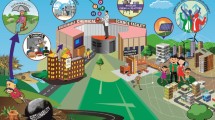Abstract
Traditional science classroom activities rely on topics and experiments that are distant from the forefront of scientific research. As a result, students view science as stagnant and far removed from real life. Through a National Science Foundation-funded Research Experiences for Teachers (RET) program, we at the University of Wisconsin-Madison (UW) Materials Research Science and Engineering Center (MRSEC) work with secondary teachers to transform cutting-edge research in nanoscale science and engineering into curriculum that is appropriate for middle- and high-school classrooms. This benefits everyone involved: teachers learn about innovative science and the process of research; UW MRSEC personnel learn about science education and the state of today's schools; and students get to test and engage with new curriculum about breakthrough research. This past summer our RET participants conducted research on and developed curriculum about “smart” papers with microencapsulation technology, fuel cells, nano biosensors and liquid crystals, glassy metals, and Wells models.
Similar content being viewed by others
References
Exploring the Nanoworld, Materials Research Science and Engineering Center, University of Wisconsin-Madison, {un{urlhttp://www.mrsec.wisc.edu/nano}}.
A.C. Payne, W.A. deProphetis, G.M. Zenner, T.G. Derenne, A.B. Ellis, W.C. Crone, “Communicating Science to the Public through a University-Museum Partnership,” to appear in the Journal of Chemical Education.
Lab Manual for Nanoscale Science and Technology, Materials Research Science and Engineering Center, University of Wisconsin-Madison, {un{urlhttp://www.mrsec.wisc.edu/edetc/nanolab/index.html}}.
Materials Science and Nanotechnology Modules for Teaching K-12 Science, Materials Research Science and Engineering Center, University of Wisconsin-Madison, {un{urlhttp://www.mrsec.wisc.edu/edetc/modules/index.html}}.
National Science Education Standards, National Academy of Sciences, {un{urlttp://www.nap.edu/readingroom/books/nses/html/}}.
National Education Technology Standards, International Society for Technology in Education National Education Technology Standards Project, {un{urlhttp://cnets.iste.org/}}.
Applications Activity: “Smart” Papers, Internships in Public Science Education, Materials Research Science and Engineering Center, University of Wisconsin-Madison, {un{urlhttp://www.mrsec.wisc.edu/edetc/IPSE/educators/smPapers.html}}.
Exploring the Nanoworld with LEGO® Bricks, Materials Research Science and Engineering Center, University of Wisconsin-Madison, {un{urlhttp://www.mrsec.wisc.edu/edetc/LEGO/bookindex.html}}.
Acknowledgments
In addition to the mentors included as co-authors on this paper, we would like to acknowledge our past RET mentors - Art Ellis, George Lisensky, Amy Payne, Eric Voss - for their contributions to the program. We would also like to thank Fiona Goodchild for her assistance with assessment and her advice on how to create a more effective RET program. This work is funded by the National Science Foundation through a Research Experiences for Teachers supplement to a Materials Research Science and Engineering Center grant (DMR-0079983). The associated Internships in Public Science Education program has also supported by grants from the National Science Foundation (DMR-0120897 and DMR-0424350). This work was also supported by the National Science Foundation through a CAREER Award to Prof. Paul Voyles (DMR-0347746).
Author information
Authors and Affiliations
Rights and permissions
About this article
Cite this article
Zenner, G.M., Crone, W.C., Gimm, J.A. et al. Turning Cutting-Edge Research into Secondary Curriculum. MRS Online Proceedings Library 861, 36–41 (2004). https://doi.org/10.1557/PROC-861-PP3.3
Published:
Issue Date:
DOI: https://doi.org/10.1557/PROC-861-PP3.3




